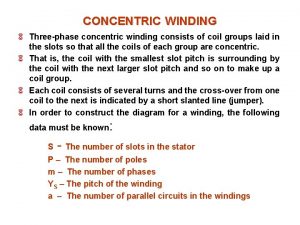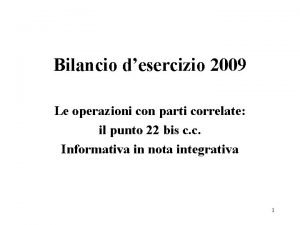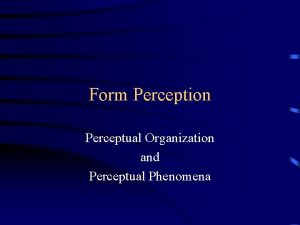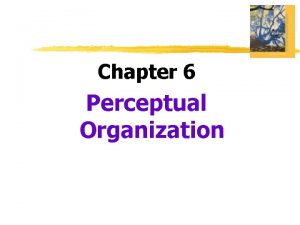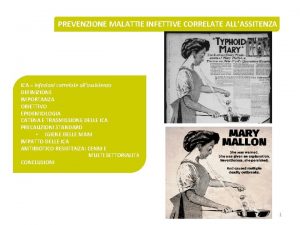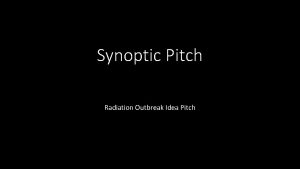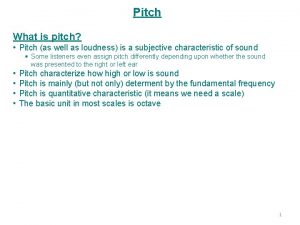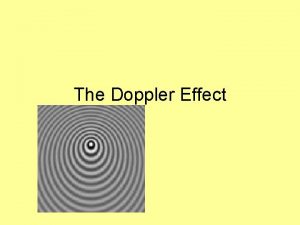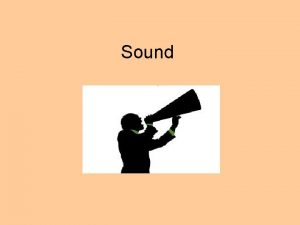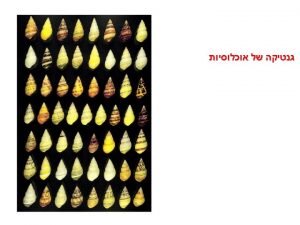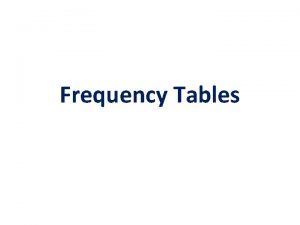Pitch The perceptual correlate of frequency the perceptual










































- Slides: 42

Pitch The perceptual correlate of frequency: the perceptual dimension along which sounds can be ordered from low to high.

The bottom line Pitch perception involves the integration of spectral (place) and temporal information across the spectrum.

Scales of pitch

mel scale From Gelfand (1998)

Pitch has two qualities • Pitch height • Pitch chroma – Octave equivalence

musical scales 1200 cents = 1 octave Equal logarithmic steps From Yost (1994)

Which of the following is NOT a scale of pitch? (A) mel scale (B) C major scale (C) sone scale 7

The two codes for frequency in the auditory nerve response are (A) the temporal code (B) adaptation code (C) the place code (D) the combine firing rate of auditory nerve fibers with the same CF 8

2 AFC Frequency Discrimination F + ∆F F Feedback Time Trial 1 Warning Interval 1 Interval 2 Respond: 1 or 2? 1 Trial 2 Warning Interval 1 Interval 2 Respond: 1 or 2? 2 Trial 3 Warning Interval 1 Interval 2 Respond: 1 or 2? 2 Which one was higher? Vary ∆F to find a threshold

Terms for frequency discrimination threshold • • ∆F frequency DL, DLF, FDL ∆F/F, Weber Fraction jnd for frequency

Frequency discrimination • Does Weber’s Law apply? • Do the results of frequency discrimination experiments suggest that people use the place code or the temporal code (phase locking) to figure out what the frequency of a tone is?

Pure-tone frequency discrimination From Yost (1994)

Weber’s Law and Frequency Discrimination From Yost (1994)

Weber’s Law seems to hold in pure -tone frequency discrimination, but only at (A) low frequencies (B) middle frequencies (C) high frequencies 14

Why does it get worse at high frequencies? From Yost (1994)

Representation of time waveform of a tone From Gelfand (1998)

Effects of tone duration Time (ms)

794 1000 1260 Frequency (k. Hz) Relative amplitude (d. B) Time (ms) 1588 Time (ms) 794 1000 1260 Frequency (k. Hz) Relative amplitude (d. B) Duration and the place code 1588 Time (ms) 794 1000 1260 Frequency (k. Hz) 1588

Prediction Shortening the duration of the tone should have a bigger effect on frequency discrimination if frequency is being coded temporally.

Effects of duration of pure-tone frequency discrimination From Moore (1997)

These and other findings suggest that a temporal code (phaselocking) is used to code low frequency tones, but that the place code is used to code high frequency tones But notice that we do better, relatively speaking, with the temporal code. People use whatever works best.

Well, tones are fine, but. . Most sounds are complex. How do we perceive the pitch of complex sounds?

The pitch of a harmonic complex • Pitch is a unitary percept: You hear one complex tone, not 6 • If a listener is asked to match the pitch of the complex to the pitch of a pure tone, they will choose a pure tone at the fundamental frequency.

Which of these would have the highest pitch? B Level (d. B) A 100 200 300 400 500 600 700 800 900 Frequency (Hz) C 100 200 300 400 500 600 700 800 900 Frequency (Hz) Neither 24

If I asked you to adjust the frequency of a tone to match the pitch of this complex, you would pick a frequency near Level (d. B) (A) 800 Hz (B) 200 Hz (C) 600 Hz (D) 100 Hz 100 200 300 400 500 600 700 800 900 Frequency (Hz) 25

In fact, if you present the harmonics alone, you still hear the pitch of the fundamental • Pitch of the missing fundamental • Virtual pitch • Residue pitch • Low pitch

If I asked you to adjust the frequency of a tone to match the pitch of this complex, you would pick a frequency near Level (d. B) (A) 800 Hz (B) 200 Hz (C) 600 Hz (D) 100 Hz 100 200 300 400 500 600 700 800 900 Frequency (Hz) 27

Possible explanations for virtual pitch Distortion? No, because masking the frequency of the fundamental doesn’t affect the pitch.

Possible explanations for virtual pitch The system isn’t just taking the difference between harmonic frequencies, because shifting the harmonics, but keeping the difference the same, changes the pitch.

Two classes of theories of complex pitch • Template (pattern) theories – Place code • Temporal theories – Temporal code (phase locking)

Template theories Level (d. B) 200 400 600 800 1000 1200 Frequency (Hz) Level (d. B) 200 400 600 800 1000 1200 ? Frequency (Hz) Level (d. B) 200 400 600 800 1000 Frequency (Hz) 1200 Hz 1200

Temporal theories From Yost (1994)

Resolved v. unresolved harmonics f 0 = 200 Hz f 0 = 220 Hz Level (d. B) 200 400 600 800 1000 1200 220 Frequency (Hz) 440 660 880 1100 1320 Relative amplitude (d. B) Frequency (Hz) 360 440 540 660 800 Frequency (k. Hz) 1020 1200

Resolved v. unresolved harmonics f 0 = 220 Hz f 0 = 200 Hz Level (d. B) 2000 2200 2400 2600 2800 2200 2420 2640 2860 3080 Frequency (Hz) Relative amplitude (d. B) Frequency (Hz) 1800 2160 2500 3100 Frequency (k. Hz) 3700 4500

Template v. temporal theories: Evidence • Existence region of virtual pitch: Occurs even when all harmonics are unresolved (albeit weaker), but also when all are resolved. • Dominance region: Resolved harmonics are more important in determining pitch

Which of the following is the amplitude spectrum of an AM tone? B Level (d. B) A 100 200 300 400 500 600 700 800 900 C Frequency (Hz) Level (d. B) Frequency (Hz) 100 200 300 400 500 600 700 800 900 Frequency (Hz) 36 B

Which of the following is the amplitude spectrum of an AM broadband noise? B Level (d. B) A 100 200 300 400 500 600 700 800 900 C Frequency (Hz) Level (d. B) Frequency (Hz) 100 200 300 400 500 600 700 800 900 Frequency (Hz) 37 B

Which of the following has a pitch? B B Level (d. B) A 100 200 300 400 500 600 700 800 900 C Frequency (Hz) Level (d. B) Frequency (Hz) 100 200 300 400 500 600 700 800 900 Frequency (Hz) 38

Evidence that argues that temporal coding must play a role Burns & Viemeister (1982): Can listeners identify melodies played with sinusoidally amplitude modulated noise? YES. (From Yost (1994)

Is pitch peripheral? • Both the place code and the temporal code in the auditory nerve response are used in pitch perception. • But pitch perception must involve neural, central processes too – Where are the templates stored and compared? – How are place and temporal information combined?

Conclusions • Both spectral (place) and temporal (phaselocking) information appear to be important in pitch perception. • The situations in which spectral and temporal information are useful in determining pitch differ. • There is no consensus on the appropriate scale of pitch.

Text sources • Gelfand, S. A. (1998) Hearing: An introduction to psychological and physiological acoustics. New York: Marcel Dekker. • Moore, B. C. J. (1997) An introduction to the psychology of hearing. (4 th Edition) San Diego: Academic Press. • Yost, W. A. (1994) Fundamentals of hearing: an introduction. San Diego: Academic Press.
 Cyclic pitch vs collective pitch
Cyclic pitch vs collective pitch Heat transfer
Heat transfer Back pitch and front pitch
Back pitch and front pitch Fine pitch vs coarse pitch propeller
Fine pitch vs coarse pitch propeller Concentric winding diagram
Concentric winding diagram Pitch 2 pitch chanhassen
Pitch 2 pitch chanhassen Types of ac winding
Types of ac winding Does height and shoe size correlate
Does height and shoe size correlate Direttamente proporzionale simbolo
Direttamente proporzionale simbolo Operazioni con parti correlate nota integrativa esempio
Operazioni con parti correlate nota integrativa esempio What is a marginal frequency
What is a marginal frequency Relative frequency bar chart
Relative frequency bar chart Observed frequency
Observed frequency How to calculate marginal relative frequency
How to calculate marginal relative frequency Average of sine wave
Average of sine wave Vmax = aw
Vmax = aw How to find conditional relative frequencies
How to find conditional relative frequencies ưu thế lai là gì
ưu thế lai là gì Tư thế ngồi viết
Tư thế ngồi viết Thẻ vin
Thẻ vin Cái miệng bé xinh thế chỉ nói điều hay thôi
Cái miệng bé xinh thế chỉ nói điều hay thôi Các châu lục và đại dương trên thế giới
Các châu lục và đại dương trên thế giới Bổ thể
Bổ thể Từ ngữ thể hiện lòng nhân hậu
Từ ngữ thể hiện lòng nhân hậu Tư thế ngồi viết
Tư thế ngồi viết Ví dụ giọng cùng tên
Ví dụ giọng cùng tên Thơ thất ngôn tứ tuyệt đường luật
Thơ thất ngôn tứ tuyệt đường luật Chúa yêu trần thế
Chúa yêu trần thế Sự nuôi và dạy con của hổ
Sự nuôi và dạy con của hổ Diễn thế sinh thái là
Diễn thế sinh thái là đại từ thay thế
đại từ thay thế Vẽ hình chiếu vuông góc của vật thể sau
Vẽ hình chiếu vuông góc của vật thể sau Công thức tính thế năng
Công thức tính thế năng Phép trừ bù
Phép trừ bù Tỉ lệ cơ thể trẻ em
Tỉ lệ cơ thể trẻ em Thế nào là mạng điện lắp đặt kiểu nổi
Thế nào là mạng điện lắp đặt kiểu nổi Lời thề hippocrates
Lời thề hippocrates Vẽ hình chiếu đứng bằng cạnh của vật thể
Vẽ hình chiếu đứng bằng cạnh của vật thể Quá trình desamine hóa có thể tạo ra
Quá trình desamine hóa có thể tạo ra Các môn thể thao bắt đầu bằng tiếng đua
Các môn thể thao bắt đầu bằng tiếng đua Hát kết hợp bộ gõ cơ thể
Hát kết hợp bộ gõ cơ thể Khi nào hổ con có thể sống độc lập
Khi nào hổ con có thể sống độc lập Dạng đột biến một nhiễm là
Dạng đột biến một nhiễm là




